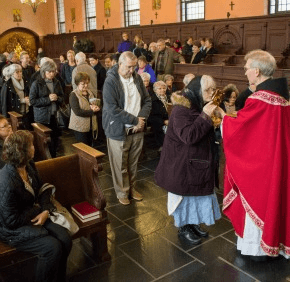By Kit Cross
Special to the Review
ELLICOTT CITY – Admirers of St. Maximilian Kolbe lined up at the Shrine of St. Anthony Jan. 15 to venerate a portion of his beard contained in an ornate reliquary.
Commemorating the 75th anniversary of the Polish saint’s death, the first-class relic is making its way across the eastern U.S. and Canada, remaining within the Archdiocese of Baltimore through Feb. 15. It is the largest tour of St. Maximilian’s relics ever mounted in the United States.
The eight-month tour commenced with the Jan. 15 opening Mass at the Shrine of St. Anthony, which happens to be one of the Archdiocese of Baltimore’s eight designated Holy Door pilgrimage sites for Pope Francis’ Holy Year of Mercy. The tour will close Aug. 14 at the same site.
Conventual Franciscan Father James McCurry, who celebrated the opening Mass, stressed that relics are not to be worshipped.
“Relics are occasions for worshipping God through the man of God who lived and walked this earth,” said Father McCurry, who as a young friar had been tasked with promoting St. Maximilian’s cause for sainthood, an effort that became his life’s work.
“(Relics) connect us with our own call to become saints,” added Father McCurry, who serves as minister provincial of the Conventual Franciscans’ Our Lady of Angels Province.
St. Maximilian, also a Conventual Franciscan friar, led a life of heroic charity that culminated in his martyrdom during World War II at the Nazi death camp Auschwitz in Poland. The patron saint of prisoners, journalists, the addicted, the pro-life movement and families, he voluntarily took the place of a fellow prisoner, a husband and father who was selected to die by starvation.
After he survived for two weeks without food, St. Maximilian’s death was hastened by lethal injection August 14, 1941.
St. John Paul II canonized him as a Martyr of Charity in 1982.
An ornate reliquary encases St. Maximilian’s relic with symbols from his life. According to Our Lady of Angels Province, the base is in the shape of Poland, his birthplace, while thorns represent the Nazi occupation. A lily and tulip are symbols of purity and martyrdom.
The opening Mass held special significance for members of the Sisters Servants of Mary Immaculate who came to participate in the veneration.
“It’s very close to our hearts,” said Sister Donna Zielinska. “(St. Maximilian’s life) reminds us to serve without limits and minister to those in our daily lives.”
The Sisters Servants of Mary Immaculate, who operate St. Joseph’s Nursing Home in Catonsville, received a special blessing from Father McCurry.
At each stop on the tour, the faithful will have the opportunity to connect with St. Maximilian through liturgy, veneration and materials provided for further prayer and study
While the relic will be outside the Baltimore archdiocese starting in mid-February, it will return to the Shrine of St. Anthony for a closing ceremony Aug. 14, St. Maximilian’s feast day.
Tour stops in the Archdiocese of Baltimore:
Jan. 18-21: Provincial House, Portiuncula Friary, Ellicott City
Jan. 22-24: St. Casimir, Canton
Jan. 29-31: St. Wenceslaus, Baltimore
Feb. 2-4: Archbishop Curley High School, Baltimore
Feb. 5-7: St. Elizabeth of Hungary, Highlandtown
Feb. 13-15: St. Clement Mary Hofbauer, Rosedale
Aug. 14: Shrine of St. Anthony, Ellicott City
View more photos on our Smugmug page.
Also see:
Curley friar recalls visit with Maximilian Kolbe


